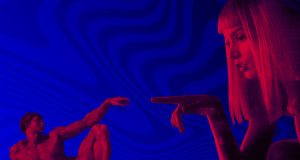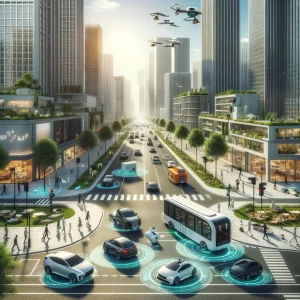Artificial Intelligence (AI) is the proof of human innovation, a tool used by everyone unconsciously in their daily lives. An illustrative example is an algorithm that auto-corrects text messages and it can be used in various social media platforms. This kind of Artificial Intelligence (AI) algorithms within their core have the brilliance of human minds such as engineers, developers, and data scientists. These individuals use their ingenuity and their creative ideas to fine-tune models and shape algorithms that will birth the AI technology.
In a recent interview, OpenAI’s Founder and CEO, Sam Altman, shed light on the evolving perspectives within the AI field. A decade ago, AI was perceived primarily as a tool for automating specific processes. However, the narrative has shifted, recognizing AI not only as an automation tool but also as a production one-a substantial paradigm shift in our understanding of artificial intelligence. Altman’s statement not only provides clarity on the definition of AI but also prompts inquiries about the ownership of AI-generated content. This question gains particular relevance in the realm of AI, reflecting its significant implications. Altman’s viewpoints prompt reflection on the subtle balance between human creativity and the generation by machines.
AI as a Powerful Tool

Considering AI as a tool highlights the crucial role of human agency in its development. This point of view underscores the complex web of human intelligence that creates algorithms capable of producing captivating text that seem to be produced by a human, images that seems to be real and in general multifaceted outputs. Moreover, if we take into consideration the complexity of an AI system, its ability to generate content is intricately tied to the human driven design of algorithms. We should not consider AI as something smart, instead it can be viewed as a powerful tool. Thanks to the coding expertise, strategic thinking, and continuous refining and updating of models, all of which blend to create an illusion of intelligence. The very essence of AI lies in the human touch, as every line of code and each parameter adjustment reflect the choices and insights of its creators.
Legal and Ethical Accountability
The intricate landscape of AI-generated content ownership is one of the most contemporary and complex issues facing the legal community. As artificial intelligence continues to advance, it raises critical questions about who holds the rights to content created by AI systems. Notably, recent legal actions against OpenAI and Meta for alleged copyright infringement highlight the challenges. This includes the use of potentially copyrighted material without consent in training data, sparking debates on ownership and authorship. We assert that AI-created content is a product of collective human ingenuity and surveillance, and deserves collective ownership. This perspective gains traction when considering the need for a robust legal and ethical framework in the AI landscape. In addition, this collective ownership approach addresses issues like copyright infringement, plagiarism, and responsible AI use. To be more precise, establishing legal and ethical accountability becomes more straightforward when an entity is attributed to a natural person (In the eyes of the law, these natural persons encompass both companies/organizations and individuals). Moreover, our stance is exemplified by a specific case in an art competition where the top prize was bestowed upon an individual who employed an AI model, named Midjourney, as the creative force behind their winning painting. This fact angered the other contestants, not solely due to concerns of ownership but also on ethical grounds, as it diminishes the value of their creative endeavors and hard work.

“Théâtre D’opéra Spatial” created by Midjourney
An AI-Generated Artwork Won First Place at a State Fair Fine Arts Competition.
Aligning with the U.K. Copyright Code and proposed U.S. Copyright Act amendments by Professor Annemarie Bridy, the focus shifts to human authorship. To overcome the legal gray area, it is suggested that human programmers and companies owning AI machines should be considered natural and legal persons, respectively. This approach holds them fully responsible under the law, balancing privileges and liabilities associated with AI-created content. Hence, this decision stands out as the most stringent among the remaining four alternatives, which can be seen below.
Additionally, recognizing collective responsibility of AI developers and Organizations, leads to the development of an appropriate legal path. Navigating the legal issues that emerge due to this new AI technology, is the cornerstone to ensuring ethical, transparent, and responsible AI practices.

Five key approaches are currently debated regarding the ownership of AI-generated content.
- A. I. system-A. I. system by itself is the owner of the A. I. generated work.
- Programmer-the programmer or programmers of the A. I. system should be the owner of the A. I. generated work.
- User-the user of the A. I. system.
- Company/Owner-the company that produces or owns the A. I. system
- Public domain-A. I. system-produced work belongs in the public domain.
- AI System Ownership indicates that AI itself should be recognized as the owner of the generated work. However, this perspective faces a lot of challenges as AI lacks natural subjective consciousness which leads to conflicts with the establishment of a copyright protection law.
- Programmer Ownership proposition asserts that those who code the AI system should be considered the rightful owners of the AI-generated work. This idea encounters complexities due to the nature of Ais self-learning capabilities. The machine autonomous operations play an important role in producing creative and original outputs. Moreover, the contributions of various programmers make it challenging to distribute the ownership given their diverse roles in the development of the algorithm.
- User Ownership suggest that the individual that uses the AI system to generate content should hold the rights. This concept raises concerns about rewarding the users for conception and not the intellectual contribution.
- Company/Owner Ownership proposes that the ownership should align with the company or the owner that produced the AI system. This argument arises concerns regarding monopolization due to the nature of these kind of technologies where large corporations with significant resources could dominate the market.
- Public domain option suggests that AI system-produced work should be freely available to the public. This might seem promising regarding short term accessibility on this technology but there are concerns about the long-term implications. If we place it in the public domain we could diminish incentives for financial and intellectual investment for future growth of the specific field.
Incentives for Innovation
Direct ownership of AI-generated outputs and associated benefits could incentivize individuals and organizations to invest more in AI research and development, potentially contributing to significant advancements in the field, but ethical considerations must also be addressed. The giants of technology industry e.g. (Microsoft, Open-AI, Apple, Meta, Google,) will be propelled to invest resources into creating powerful AI tools which will lead into accelerating processes. The competition between them can be beneficial for the rest of the world. To be more precise, when companies compete in the development of AI, each strives to surpass the others. This competition can lead to better quality products and a wider range of prices, as companies differentiate themselves to attract more customers. Moreover, this could benefit society by leading to quicker breakthroughs in areas like healthcare, environmental solutions, and advanced materials.
On the other hand, we must consider the copyrights problems that will arise if we solely give ownership to individuals or the companies that created the AI. The issues arise when the models are trained with data that belong to a creator, for example a painting, a song etc. We suggest fostering collaboration in AI-generated content, such as music or text, by exploring co-ownership with data creators or introducing tailored royalties based on their contributions. This will ensure fair compensation and, uphold licensing rights. Furthermore, this balanced approach encourages innovation while it promotes ethical distribution and responsibility for the usage of data, creating a sustainable system for both creators and developers. Balancing competition and cooperation is important for growing innovation. Hence, a well-designed ownership model helps achieve this balance.
In conclusion, we strongly believe that a well-designed ownership model is crucial for the legal complications that comes with AI generated material. A balanced model that would take into consideration co-ownership, royalties, and fair pay. A framework for an innovative environment that values cooperation, fairness, and ethical practices. This approach acknowledges the contributions of human creators and simultaneously ensures the responsible and sustainable development of AI technology.


